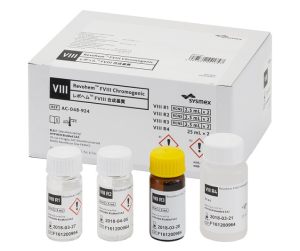News
News
Sysmex Launches the Revohem FVIII Chromogenic, a Coagulation Factor VIII Assay Reagent
-Helping to Diagnose and Assist in Treatment of Hemophilia A-
Sysmex Corporation (HQ: Kobe, Japan; Chairman and CEO: Hisashi Ietsugu) announces the launch in Japan of a new product in the hemostasis field: Revohem FVIII Chromogenic, a coagulation factor VIII assay reagent.
Using the chromogenic assay as its measurement principle, this product is used for measuring coagulation factor VIII in blood plasma. The new product can be used with Sysmex’s automated blood coagulation analyzers CS-5100/CS-2500/CS-2400/CS-2100i/CS-2000i/CS-1600.
The blood flowing through our bodies typically maintains a fine balance between the mechanism that causes the blood that escapes outside the vessels to clot (hemostasis), the mechanism that prevents the blood flowing inside our vessels from clotting (coagulation inhibition), and the mechanism dissolving blood clots (fibrinolysis) and returning them to their original liquid state. An imbalance between these functions can lead to conditions in which the blood does not clot, as in hemophilia.1 Alternatively, conditions can emerge as a result of blocked blood vessels, such as cerebral infarction and deep vein thrombosis.
Hemophilia is classified into two varieties—hemophilia A and hemophilia B—depending on the type of coagulation factor that is deficient. Hemophilia A is a hemorrhagic disease that occurs due to a reduced hemostatic function stemming from a lack of coagulation factor VIII in the blood. Diagnosing hemophilia A involves quantitative testing for coagulation factor VIII. This testing is also conducted to monitor the disease after coagulation factor VIII drugs have been administered.
Quantitative testing for coagulation factor VIII mainly uses either the coagulation one-stage assay (using an APTT reagent) or the chromogenic assay. To date, the coagulation one-stage assay has been used more widely. However, with this method, measurement values are known to deviate, depending on the type of reagent used.
For this reason, the chromogenic assay is commonplace in Europe, and the Council of Europe publication European Pharmacopoeia requires the titer of all coagulation factor drugs to be measured with the chromogenic assay. In Japan as well, the Japanese Society on Thrombosis and Hemostasis calls for the introduction of factor VIII assay testing using the chromogenic assay.2
Furthermore, recent years have seen progress in the development of “extended the half-life of coagulation factor drugs”,3 aimed at reducing the administration frequency of factor VIII drugs used to treat hemophilia A. Quantitative testing for coagulation factor VIII using the chromogenic assay has demonstrated utility in monitoring the administration of extended the half-life of coagulation factor drugs and assisting in diagnosis of minor hemophilia A by increasing the consistency of measurement values of the clinical symptoms.
The product Sysmex is launching, Revohem FVIII Chromogenic, is a reagent for quantitative testing of coagulation factor VIII using the chromogenic assay. This reagent can be used on Sysmex’s automated blood coagulation analyzers CS-5100/CS-2500/CS-2400/CS-2100i/CS-2000i/CS-1600.
In addition to being in alignment with the recommended testing methods of academic societies in Japan and overseas, this launch extends Sysmex’s reagent lineup in response to diverse customer needs.
Sysmex aims to continue working to reduce the burden on patients and help boost the quality of testing, while supporting its customers.
New Product Overview
| Name: | Revohem FVIII Chromogenic |
| Target use: | Measuring coagulation factor VIII in the blood plasma |
| Target market: | Japan |
| Target facilities: | Large-scale hospitals, commercial labs, other |
| Launch: | September 2017 |
| NHI points: | 229 |

| 1 |
Hemophilia: |
| 2 | Hemophilia Group, The Japanese Society on Thrombosis and Hemostasis, 2015, 26(4), 468-469. |
| 3 | Extended the half-life of coagulation factor drugs: These drugs extended half-life in the blood plasma beyond that of conventional blood coagulation factor drugs, allowing for regular administration only once every three to five days—or once per week depending on the patient’s disease state. Such drugs are therefore expected to decrease the frequency of intravenous injection, reducing the burden on the patient. |
- Information contained in the news release is current as of the date of the announcement,
but may be subject to change without prior notice.
